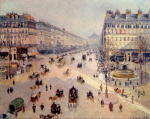All of this discussion, stemming from Jeff's initial complaint, to the debate on urban/suburban, to Charlie's wonderful street grid proposal, to the chatter about Tatte, have helped synthesize a core conception of urbanism for me:
Great urban areas invite and enable ongoing discovery.
I can envision wandering through Charlie's street grid, unsure of what will be on the next block - maybe a shop I find cool, maybe a park I wasn't looking for, but "oh that looks like a great place to relax for a minute before I have to rush off." Maybe I buy a sandwich I wasn't planning to buy. Maybe I see a window sign advertising live music tonight - I wasn't planning to walk back down this street, but this sounds good, and it's been a while since I caught some live music, so I will.
Whether it's the suburbs or (as Jeff put it) a faux-urban area: there's minimal or no discovery. You don't really feel invited in, or, you can predict exactly what's down the other end of that street, so why bother checking it out. Whether its urban-dense or suburban-non-dense, it doesn't matter if you sense it's just a repeating pattern of the known, or long blank glass walls of indifference, or a cluster of Avalon-branded uber-dorms for well-paid young professionals.
When you stand at one of CX's few pedestrian inlets, your gaze actually extends quite far. It prompts you to subconsciously infer a pattern: lots of lab buildings, a bunch of apartment buildings; it gives you a confidence (false or otherwise) that you already know what all of this is. By contrast, when you gaze into a true urban street grid, you see corners and nooks and crannies and inlets and outlets and sandwich board signs on the sidewalks and colorful awnings; you think: hmm, let me get lost in here for a while. That's what a city is to me: "maybe I'll discover something new today; maybe I, personally, feel a bit lost, but here in this city, I know I'm not alone."
CX inspires no discovery for me yet. At present, it doesn't seem like it ever will. But, nonetheless, I am rooting for it to.

 IMG_6414
IMG_6414